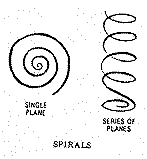The Synergistic Dynamics of Art, Mathematics, & Science
An Interdisciplinary Project at Stowe Middle School
[©Frederick David Abraham, project contributors, and sources]

Glossary
Language is one of the basic cognitive skills that shape our mental life, making not only communication possible, but influencing all our thought patterns. It short, it is a principal vehicle of our intelligence. Art, math, and science are all specialized cognitive skills and are varieties of language. Some of the most important vocabulary on the project will be added here as we learn it. Some will be our own definitions; some will come from dictionaries.
Dictionary and source codes:
AH: The American Heritage Dictionary of the English Language. Houghton Mifflin, 1978)
II: Iligan Institute of Technology, Philippines
MM: Moscow Middle School, Russia
SM: Stowe Middle School, USA.
WN: Webster's New World Collegiate Dictionary, 3rd Ed. (Macmillan, 1996)
Pattern (noun):
1. a. An archetype. b. An ideal worthy of imitation: a pattern of womanly virtues.
2. A plan, diagram, or model to be followed in making things: dress pattern.
3. A representative sample; specimen.
4. a. Any artistic or decorative design: a paisley pattern.
b. A design of natural or accidental origin: "the crystalline pattern of new ice on a country pool" (William Carlos Williams).
5. A composite of traits or features characteristic of an individual: behavioral patterns.
6. Form and style in an artistic work or body of artistic works.
7. a. The configuration of identically aimed rifle shots upon a target.
b. The distribution and spread of shot from a shotgun.
8. Enough material to make a complete garment. (AH)
1 a person or thing considered worthy of imitation or copying.
2 a model or plan used as a guide in making things: set of forms to the shape of which material is cut for assembly into the finished article /a dress pattern/
3 the full-scale model used in making a sand mold for casting metal
4 something representing a class or type; example; sample
5 an arrangement of form; disposition of parts or elements; design /wall-paper patterns, the of a novel/
6 a regular, mainly unvarying way of acting or doing /behavior patterns/
7 a predictable or prescribed route, movement, etc. /traffic pattern, landing pattern/
8 a) grouping or distribution, as a numbr of bullets fired at a mark
b) something, as a diagram, showing such distribution
9* [Now Rare] sufficient material for making a garment (WN)
Spiral (noun):
1. The locus in a plane of a point moving around a fixed center at a monotonically increasing or decreasing distance from the center.
2. The three-dimensional locus of a point moving parallel to and about a central axis at a constant or continuously varying distance; a helix.
3. Something having the form of such a curve: spirals of smoke.
4. The course or flight path of an object rotating on its longitudinal axis, as of an airplane or football.
5. A continuously accelerating increase or decrease: the wage-price spiral. (AH)
adjective (given first as it was used in defining the noun):
 1 circling around a central point in a flat curve that constantly increases (or decreases) in size; coiled or coiling in one plane
1 circling around a central point in a flat curve that constantly increases (or decreases) in size; coiled or coiling in one plane
2. circling around a central axis in a curve of conical or cylindrical form; coiled or coiling in one plane.
noun:
1 a spiral curve occurring in a single plane
2 a spiral curve occurring in a series of planes; helix
3 something having a spiral form, as a wire for holding sheets in some notebooks
4 a spiral path or flight /the descending spiral of a falling leaf/
5 a section or segment of a spiral
6 a continuous, widening decrease or increase /an inflationary spiral ending in financial collapse/
7 Football a kick or pass in which the ball rotates on its longer axis as it moves through the air (WN)

Created: 12/20/96 Updated: 1/10/97 1 circling around a central point in a flat curve that constantly increases (or decreases) in size; coiled or coiling in one plane
1 circling around a central point in a flat curve that constantly increases (or decreases) in size; coiled or coiling in one plane